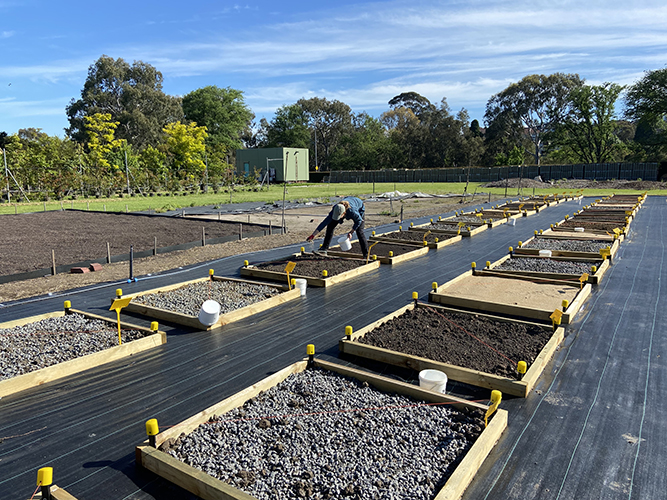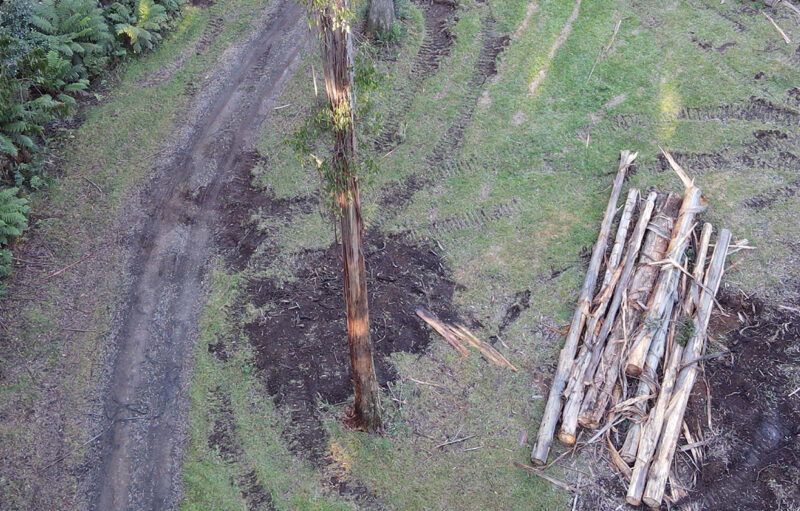PARK WATCH Article June 2024 |
Katherine Horsfall is a PhD candidate at the University of Melbourne, researching urbanisation as a huge driver for the loss of native grassy ecosystems in southeast Australia
I investigate novel ways to reinstate species from critically endangered Natural Temperate Grassland and Grassy Eucalypt Woodland plant communities in cities and towns, by creating native wildflower meadows.
This work builds on pioneering research by Paul Gibson Roy, John Delpratt and others which shows we can restore native grassy ecosystems using direct seeding, providing that adequate site preparation is used to overcome the challenges of elevated soil nutrients and weeds. Their innovative methods use soil scalping, or removing surface soils prior to sowing, which gives seeds the best chance of establishing by limiting competition from nutrient-hungry exotics.
These techniques create species-rich and resilient restorations full of native wildflowers. They, however, cannot be used in some sites, such as those with contaminated soils or underground services. These situations are common in cities, so we need additional techniques to bring native grassy ecosystems back to urban streets.
Trialling techniques for seeding grassland species
During my Masters research, I was lucky to work alongside the City of Melbourne to refine approaches to direct seeding indigenous grassland species in Royal Park.
We sowed plots around the park, only to see seed washed away in heavy rains, followed by an extended dry period with little germination. At the time I was investigating northern hemisphere efforts to reinstate urban biodiversity through the creation of wildflower meadows.
These plantings showcase flowering plants, consistent with the research that tells us people are more likely to be accepting of ‘messier’ urban vegetation if it is full of flowers in a range of colours.
Wildflower meadows are also designed to reduce maintenance costs, requiring cutting or mowing once a year as opposed to the regular mowing required for turfgrass.
Meadows are direct seeded, and typically feature a cosmopolitan selection of species from around the world, selected for their capacity to establish from seed and persist in densely layered, rich plantings. They also rely on techniques to reduce weed competition, such as using a layer of low-nutrient sand mulch to bury weed seeds.
As a horticulturalist, I wanted to see if we could combine some of these techniques with direct seeding of indigenous species to achieve restoration outcomes. So, the imperilled Masters research quickly became a pilot of using sand and irrigation to push rapid germination in our sown species. And it worked!
Experiments in sowing native seeds
This led on to PhD research. My initial experiment investigated what was possible at a larger scale, with 27 indigenous grasses and wildflowers sown in Royal Park on two depths of sand and site soils, with or without jute mesh.
We were keen to see if there were differences in the plant community that emerged on the different sand depths, as well as to understand if sand reduced labour requirements for hand weeding during the first year of plant establishment.
We found weeding requirements were the least on the deepest sand profile and we had greater species richness and more of our beautiful forb species on this treatment. However, the addition of jute led, interestingly, to greater dominance of sown grasses, lower species richness and a greater abundance of slugs. Native slugs are not a feature of our grassy ecosystems, so our grassland plants have evolved with few defences against slug grazing.
We concluded that jute was improving habitat for introduced slug species and that slugs were in turn reducing the abundance of vulnerable forb seedlings.
Beyond these research outcomes, we also found that there was a good level of enthusiasm for the indigenous meadow planting in the local community. People often stopped by the meadow, interested to learn more and admire the flowers.
Developing techniques for scale and sustainability
The balance of my PhD research considers how we can adapt these techniques to make them more sustainable.
Having established the sand layer worked, I wanted to consider the viability of recycled waste subsoils as an alternative to sand. Subsoils are also low-in nutrients and weed seeds as they occur deeper in the soil profile and are more like the low nutrient soils we find in remnant grasslands.
So, in later experiments I compared sand and subsoils, finding plants sown in subsoils grow bigger and faster, above and below ground. This means that plant cover is more rapidly achieved in the recycled product, leaving fewer gaps for weed invasion. This has budget-friendly implications for larger scale restorations, or in lower maintenance landscapes that may not receive as much effort to manage weeds during establishment.
This is promising, as we have a massive restoration effort ahead of us if we’re to meet commitments in Victoria to restore native grasslands and grassy woodlands. This research is already escaping the laboratory, with Metro Trains recently sowing indigenous species onto a subsoil cap to determine if they can use this method to achieve their ambition of restoring degraded grasslands along the rail network.
Bringing wildflowers back to our cities
Alongside the PhD research I am also helping other organisations, including City of Melbourne and Royal Botanic Gardens Victoria, to create new meadows around the city. Beyond this, a successful Australian Research Council linkages project means our terrific team of researchers will get to continue working with fantastic partner organisations, to refine approaches to making meadows with recycled, low nutrient construction wastes.
All in all, there is huge scope for this work to snowball into widespread restoration outcomes, but we need the right support for seed production, which is currently not produced commercially at sufficient scale.
Without seed, we’re limited in what we can do. I’m passionate about growing our capacities in this critical industry in future. Wildflower meadows are a promising approach to curb biodiversity loss, bring beauty and nature back into cities and towns while creating new ways for us to better care for this country. I hope these approaches continue to grow legs, or petals, or leaves…
- Read the latest full edition of Park Watch magazine
- Subscribe to keep up-to-date about this and other nature issues in Victoria
- Become a member to receive Park Watch magazine in print

